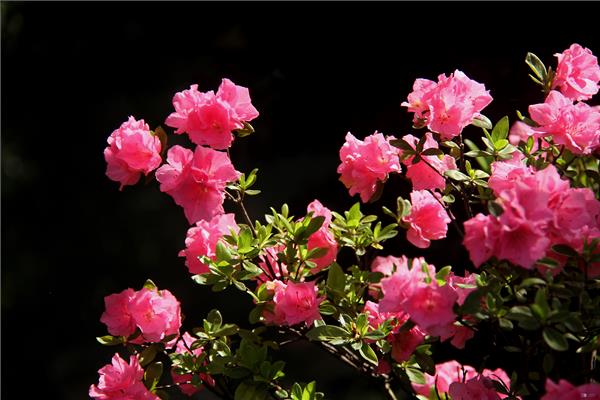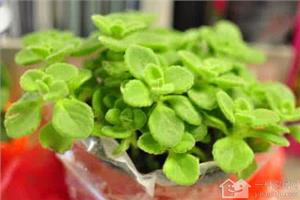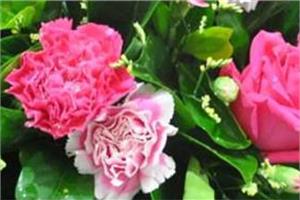How to protect azaleas? how to fertilize azaleas?
Azalea species are very many, its flowers bright, lush foliage, ornamental value is very high, is a good choice to decorate the courtyard. Azaleas love fertilizer, how should azaleas be fertilized? Let's get to know each other!

1. Selection of flowerpots for rhododendron cultivation
1, flowerpot pot quality requirements: can use clay flowerpot, plastic pot, porcelain pot, pottery pot and so on.
2, flowerpot size: planting azalea seedlings flowerpot size and seedling crown diameter consistent; planting azalea seedling flowerpot size for its crown diameter 3/4; adult seedling azalea flowerpot size for its crown diameter 1/2.
2. Potted soil preparation for rhododendron culture
Azaleas prefer acidic (pH 4.5-5.5), loose, well-drained soils. Avoid calcareous alkaline soil, avoid clayey soil. The following formula can be used for family cultivation: Belgian rhododendron: rotten leaf soil: peat soil: sand =5:2:3; spring and summer rhododendron: garden soil: peat soil: sand =3:5:2. Mix in proper amount of bone powder and stir well.
Third, the temperature and light requirements of rhododendron culture
Potted rhododendrons are generally potted in spring from March to April, and can also be potted in autumn. When the pot needs to be transplanted with soil, after planting, pour water and place it in the shade.
Northern potted rhododendron, generally in mid-October into the indoor winter, after entering the room placed in the sun. At the beginning of the room, attention should be paid to frequent window ventilation. Winter room temperature to about 10℃ is appropriate, not too high, otherwise, plant physiological activities strengthen, a large number of nutrients consumption, affecting the flowering and growth of the next year; at the same time should be given sufficient light. The next year in late April after the room, at this time the sun is softer, around noon should be appropriate shade, after summer must be moved to a cool and ventilated place maintenance. Because rhododendron belongs to shade flower, spring, summer and autumn all need to be maintained under shade shed, especially in summer under the condition of hot sun for a long time, easy to cause branches and leaves withered, growth stagnation, whole plant death. Autumn day to see the light time gradually lengthened, to the end of autumn to stop shading.
4. Watering methods for rhododendron cultivation
Keep the pot soil moist during the growth period. The water demand during flowering period from April to June is relatively large. Spray water on the ground and foliage during the high temperature season from July to August to keep the air moist. After September, the temperature will gradually cool down, so that the water content of the pot soil will gradually decrease. In winter, it will enter the dormant period and water less.
Because the root system of rhododendron is shallow root, it is afraid of drought and waterlogging, improper watering, light will fall leaves, heavy will die, therefore, watering is one of the key measures to raise Du Gu bird flower. Watering should depend on the season and growing period of the plant. Spring budding, flowering period, water consumption is more, watering should be timely, if the basin dehydration, flowers wither, flowering shortened. It is advisable to keep the basin soil moist during this period. In summer, azalea branches and leaves grow vigorously, the temperature is high, and the water evaporates quickly. In addition to watering once a day, water should be replenished at any time. If there is a slight negligence, the pot soil will be too dry, causing the leaf color to turn yellow, the leaf center to curl, or even dry and die.
Because rhododendrons like to be wet, in summer, they should spray leaves with clean water and sprinkle water on the ground around the flower pots to increase air humidity and reduce temperature; in autumn, flower buds have formed, the temperature is decreasing day by day, and the weather turns cool. At this time, the pot soil can be kept dry. Winter temperature is low, azalea is in dormancy or semi-dormancy state, water consumption is less, so watering should be strictly controlled, too much water is easy to rot roots, but this period should be every 5~7 days with water close to room temperature spray once branches and leaves, so as to facilitate the freshness of plants. Azalea watering should pay attention to the quality of water, the use of rainwater is more appropriate, such as tap water, must be stored in containers for 1 to 2 days before use.
5. Fertilization methods for rhododendron culture
Rhododendron root shallow and thin, absorption capacity is weak, so fertilizer must master the principle of "thin fertilizer and frequent application". If the fertilizer is too thick or the fertilizer is not fully decomposed, it is easy to cause rotten roots, withered leaves and death. Especially for 1~2-year-old seedlings, pay more attention to the amount of fertilizer, otherwise it is easy to cause fertilizer damage.
In February to March before spring cuckoo flowering, liquid fertilizer mainly composed of phosphorus should be applied once every 10 to 15 days to promote large and colorful flowers; in March to April, the same fertilizer should be applied to summer cuckoo, which can make flowers large, color good, petals thick and flowering for a long time. Fertilization should be stopped during flowering period, otherwise it is easy to drop flowers and grow leaves, affecting the viewing effect; nitrogen-based fertilizer should be applied every 10 days after flowering to promote new branches. After late July, it is the flower bud differentiation period of Rhododendron, and liquid fertilizer based on phosphorus should be applied once every 10~15 days to promote flower bud differentiation. Winter dormancy period does not need fertilizer, topdressing should be stopped.
6. Pruning methods of rhododendron culture
Rhododendron germination force, branches and dense, should be cut after flowering through dense branches, thin branches, dead branches, diseased branches, residual branches, cross branches, excessive long branches, in order to facilitate ventilation and light transmission. Do not cut short the remaining branches. The leaves of azaleas are clustered at the top of the branches. After flowering, a new branch will sprout and grow clusters of new leaves. The old leaves will fall off immediately, and then the terminal buds will begin to differentiate into flower buds in the coming year. If this branch is cut off, it will affect the number of flowers in the following year.
VII. Precautions for Rhododendron Culture
Rhododendron is a typical acid soil flower, in order to prevent yellowing, 0.2% ferrous sulfate should be applied once every 20 days. If you find yellow leaves, with 0.2% ferrous sulfate water spray directly to the leaves, you can make the leaves from yellow to green.
2. Family flower cultivation. If you want azaleas to bloom during the Spring Festival, you can use the method of breaking their dormant period. In the middle of December, the spring cuckoo which is about to be pregnant is moved into the indoor sunny place, the room temperature is kept above 5 DEG C, thin fertilizer is applied every 10~15 days, the pot soil is dried, watering is carried out, and water is often sprayed on the leaf surface to increase humidity, so that the flower can be bloomed before the Spring Festival.
3, azaleas grow slowly, generally can be replaced every two years pot, change pot should be carried out after the flowers fade. When changing pots, fill them with new culture soil. Generally, 8 parts of rotten leaf soil (peat soil), 1 part of garden soil and 1 part of river sand are mixed to prepare culture soil, and a small amount (about 50 grams per pot) of decomposed oil residue or chicken manure is added as base fertilizer.
4. During the growth period of rhododendron, adventitious buds are often easy to sprout on stems and branches, which should be erased in time to avoid disturbing the plant type. Pregnant bud, such as found too many buds, should remove the excess buds, each flower only one bud, in order to concentrate nutrients, promote flower color Yan. Rhododendron flower after flowering is not easy to fall off, in order to reduce nutrient consumption, should be removed in time to promote bud germination.
5. Breeding methods of rhododendron culture
Rhododendron can be inserted, grafting and layering methods such as propagation, mainly inserted. Mass propagation can be used full light cutting seedling method, rooting fast, high survival rate; a small number of propagation can be inserted into the flowerpot. Early summer and early autumn planting, after planting shade, moisture.
3 parts of rotten leaf soil, 1 part of garden soil and 6 parts of river sand mixed evenly or 5 parts of rotten leaf soil and 5 parts of river sand (or pure sand). The cuttings should be annual branches with short internodes, strong growth, no disease and insect damage, lignification at the base, and the cuttings should be 6~10 cm long. Before cutting, put medical vitamin B12 into the base of cutting. Dip it in the liquid medicine, take it out and air it for 2~3 minutes. The sting takes root about 10 days earlier, and it takes root more and grows faster.
When cutting, first use chopsticks or thin sticks to make a hole in the substrate, then insert the cuttings, gently compact them with hands, spray water through them, and make the base of the cuttings tightly combine with the soil. After planting, cover the flowerpot with a plastic bag, tie it tightly with strings around, and put it in the shade; spray water once a day in the morning and evening, stop spraying water after a week, and only need to keep the pot soil moist frequently; keep shade within a month, and gradually accept scattered light after germination; keep the temperature at 18℃~25℃. General varieties can take root 40~60 days after insertion.
When the family raises a flower, in order to blossom earlier, also can adopt tall branch layering method to breed. That is to say, in March, 2~3-year-old stout branches are selected for girdling, covered with plastic bags, put rotten leaf soil in the bags, keep wet frequently, the temperature is about 20℃~25℃, root can be taken in about 5~6 months, and flower can be bloomed in the spring of the next year.
The above is the relevant introduction of this article, I believe you have read this also have a simple understanding, if necessary, you can continue to pay attention to No. 1 home network, to learn more information.
If too many flower buds are found, they should be removed and only one flower bud should be left for each flower branch to concentrate nutrients and promote large and colorful flowers. The residual flowers are not easy to fall off after flowering. In order to reduce nutrient consumption, the residual flowers should be removed in time to promote the germination of new buds.
5. Breeding methods of rhododendron culture
Rhododendron can be inserted, grafting and layering methods such as propagation, mainly inserted. Mass propagation can be used full light cutting seedling method, rooting fast, high survival rate; a small number of propagation can be inserted into the flowerpot. Early summer and early autumn planting, after planting shade, moisture.
3 parts of rotten leaf soil, 1 part of garden soil and 6 parts of river sand mixed evenly or 5 parts of rotten leaf soil and 5 parts of river sand (or pure sand). The cuttings should be annual branches with short internodes, strong growth, no disease and insect damage, lignification at the base, and the cuttings should be 6~10 cm long. Before cutting, put medical vitamin B12 into the base of cutting. Dip it in the liquid medicine, take it out and air it for 2~3 minutes. The sting takes root about 10 days earlier, and it takes root more and grows faster.
When cutting, first use chopsticks or thin sticks to make a hole in the substrate, then insert the cuttings, gently compact them with hands, spray water through them, and make the base of the cuttings tightly combine with the soil. After planting, cover the flowerpot with a plastic bag, tie it tightly with strings around, and put it in the shade; spray water once a day in the morning and evening, stop spraying water after a week, and only need to keep the pot soil moist frequently; keep shade within a month, and gradually accept scattered light after germination; keep the temperature at 18℃~25℃. General varieties can take root 40~60 days after insertion.
When the family raises a flower, in order to blossom earlier, also can adopt tall branch layering method to breed. That is to say, in March, 2~3-year-old stout branches are selected for girdling, covered with plastic bags, put rotten leaf soil into the bags, keep wet frequently, the temperature is about 20℃~25℃, root can be taken in about 5~6 months, and flower can be bloomed in the spring of the next year.
The above is the relevant introduction of this article, I believe you have read this also have a simple understanding, if necessary, you can continue to pay attention to No. 1 home network, to learn more information.
- Prev

Can touch incense be kept indoors for a long time?
Can touch incense be kept indoors for a long time?
- Next

What does the carnation with different flower number represent? the flower meaning of the carnation.
What does the carnation with different flower number represent? the flower meaning of the carnation.
Related
- Wuhan Hospital Iron Tree Blooming Result Was Instantly Frightened by the Gardener Master
- Which variety of camellia is the most fragrant and best? Which one do you like best?
- What is the small blue coat, the breeding methods and matters needing attention of the succulent plant
- Dormancy time and maintenance management of succulent plants during dormancy
- Minas succulent how to raise, Minas succulent plant pictures
- What are the varieties of winter succulent plants
- How to raise succulent plants in twelve rolls? let's take a look at some experience of breeding twelve rolls.
- Attention should be paid to water control for succulent plants during dormant period (winter and summer)
- Watering experience of twelve rolls of succulent plants
- Techniques for fertilizing succulent plants. An article will let you know how to fertilize succulent plants.

